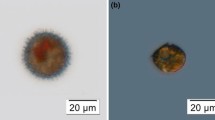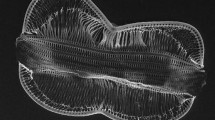Abstract
In the present study, we have investigated the conditions influencing encystment and excystment in the dinoflagellate Gyrodinium instriatum under laboratory conditions. We incubated G. instriatum in modified whole SWM-3 culture medium and in versions of modified SWM-3 from which NO3 −, PO4 3−, NO3 − + PO4 3−, or Si had been omitted and observed encystment. Percentage encystment was high in the media without N and without P, while the percentage encystment in the medium lacking both N and P was highest. Moreover, to investigate N or P concentration which induced the encystment, Gyrodinium instriatum was also incubated in media with different concentrations of inorganic N and P; the concentrations of NO2 − + NO3 − and PO4 3− were measured over time. The precursors of cysts appeared within 2 or 3 days of a decrease in NO2 − + NO3 − or PO4 3− concentration to values lower than 1 µM or 0.2 µM, respectively. When cysts produced in the laboratory were incubated, we observed excystment after 8–37 days, without a mandatory period of darkness or low temperature. We incubated cysts collected from nature at different temperatures or in the dark or light and observed excystments. Natural cysts excysted at temperatures from 10 to 30°C, in both light and dark, but excystment was delayed at low temperatures. These studies indicate that G. instriatum encysts in low N or P concentration and excysts over a wide temperature range, regardless of light conditions, after short dormancy periods.
Similar content being viewed by others
References
Anderson, D. M. and K. Rengefors (2006): Community assembly and seasonal succession of marine dinoflagellates in a temperate estuary: the importance of life cycle events. Limnol. Oceanogr., 51, 860–873.
Anderson, D. M. and D. Wall (1978): Potential importance of benthic cysts of Gonyaulax tamarensis and G. excavate in initiating toxic dinoflagellate blooms. J. Phycol., 20, 224–234.
Anderson, D. M., D. M. Kulis and B. J. Binder (1984): Sexuality and cyst formation in the dinoflagellate Gonyaulax tamarensis: cyst yield in batch cultures. J. Phycol., 20, 418–425.
Anderson, D. M., D. W. Coats and M. A. Taylor (1985): Encystment of dinoflagellate Gyrodinium uncatenum: temperature and nutrient effects. J. Phycol., 21, 200–206.
Anderson, D. M., C. D. Taylor and E. V. Armbrust (1987): The effect of darkness and anaerobiosis on dinoflagellate cyst germination. Limnol. Oceanogr., 32, 340–351.
Anderson, D. M., B. A. Keafer, W. R. Geyer, R. P. Signell and T. C. Loder (2005): Toxic Alexandrium blooms in the western Gulf of Maine: The plume advection hypothesis revisited. Limnol. Oceanogr., 50, 328–345.
Azanza, R. V., F. P. Siringan, M. L. San Diego-Mcglone, A. T. Yñiguez, N. H. Macalalad, P. B. Zamora, M. B. Agustin and K. Matsuoka (2004): Horizontal dinoflagellate cyst distribution, sediment characteristics and benthic flux in Manila Bay, Philippines. Phycol. Res., 52, 376–386.
Binder, B. J. and D. M. Anderson (1987): Physiological and environmental control of germination in Scrippciella trochoidea (Dinophyceae) resting cysts. J. Phycol., 23, 99–107.
Blackburn, S. and N. Parker (2005): Microalgal life cycles: encystment and excystment. p. 399–417. In Algal Culturing Techniques: A Book for All Phycologists, ed. by R. A. Andersen, Elsevier, Amsterdam.
Blackburn, S. I., G. M. Hallegraeff and C. J. Bolch (1989): Vegetative reproduction and sexual life cycle of the toxic dinoflagellate Gymnodinium catenatum from Tasmania, Australia. J. Phycol., 25, 577–590.
Bravo, I. and D. M. Anderson (1994): The effect of temperature, growth medium and darkness on excystment and growth of the toxic dinoflagellate Gymnodinium catenatum from northwest Spain. J. Plankton Res., 16, 513–525.
Cushing, D. H. and J. W. Horwood (1994): The growth and death of fish larvae. J. Plankton Res., 3, 291–300.
Endo, T. and H. Nagata (1984): Resting and germination of cysts of Peridinium sp. (Dinophyceae). Bull. Plankton Soc. Jpn., 31, 23–33 (in Japanese with English abstract).
Engel, M. and H.-J. Hirche (2004): Seasonal variability and inter-specific differences in hatching of calanoid copepod resting eggs from sediments of the German Bight (North Sea). J. Plankton Res., 26, 1083–1093.
Figueroa, R. I. and I. Bravo (2005): A study of the sexual reproduction and determination of mating type of Gymnodinium nolleri (Dinophyceae) in culture. J. Phycol., 41, 74–83.
Garcés, E., I. Bravo, M. Vila, R. I. Figueroa, M. Masó and N. Sampedro (2004): Relationship between vegetative cells and cyst production during Alexandrium minutum bloom in Arenys de Mar Harbour (NW Mediterranean). J. Plankton Res., 26, 637–645.
Itakura, S., K. Nagasaki, M. Yamaguchi and I. Imai (1996): Cyst formation in the red tide flagellate Heterosigma akashiwo (Raphidophyceae). J. Plankton Res., 18, 1975–1979.
Itoh, K. and I. Imai (1987): Rafido-So. p. 122–130. In Japan Fisheries Resources Conservation Association, A Guide for Studies of Red Tide Organisms, ed. by The Japan Fisheries Resource Conservation Association, Shuwa (in Japanese).
Jimenez, R. (1993): Ecological factors related to Gyrodinium instriatum bloom in the inner estuary of the Gulf of Guayaquil. p. 257–262. In Toxic Phytoplankton Blooms in the Sea, ed. by T. J. Smayda and Y. Shimizu, Elsevier, Amsterdam.
Joyce, L. B. and G. C. Pitcher (2006): Cysts of Alexandrium catenella on the west coast of South Africa: distribution and characteristics of germination. African J. Marine Sci., 28, 295–298.
Kamiyama, T. and M. Tsujino (1996): Seasonal variation in the species composition of tintinnid ciliates in Hiroshima Bay, the Seto Inland Sea of Japan. J. Plankton Res., 18, 2313–2327.
Katajisto, T. (1996): Copepod eggs survive a decade in the sediments of the Baltic Sea. Hydrobiol., 320, 153–159.
Kojima, N. and S. Kobayashi (1992): Motile cell-like cyst of Gyrodinium instriatum Freudenthal et Lee (Dinophyceae). Rev. Palaeobot. Palynol., 74, 239–247.
Kremp, A. and D. M. Anderson (2000): Factors regulating germination of resting cysts of the spring bloom dinoflagellate Scrippsiella hangoei from the northern Baltic Sea. J. Plankton Res., 22, 1311–1327.
Matsuoka, K. (1985): Archeopyle structure in modern gymnodinialean dinoflagellate cysts. Rev. Palaeobot. Palynol., 44, 217–231.
McQuoid, M. R. and L. A. Hobson (1996): Diatom resting stages. J. Phycol., 32, 889–902.
Montresor, M. and D. Marino (1996): Modulating effect of cold-dark storage on excystment in Alexandrium psuedogonyaulax (Dinophyceae). Mar. Biol., 127, 55–60.
Nagai, S., Y. Matsuyama, S. J. Oh and S. Itakura (2004): Effect of nutrients and temperature on encystment of the toxic dinoflagellate Alexandrium tamarense (Dinophyceae) isolated from Hiroshima Bay, Japan. Plankton Biol. Ecol., 51, 103–109.
Nagasoe, S. (2006): Studies on the developmental mechanism of red tide blooms of the dinoflagellate Gyrodinium instriatum Freudenthal et Lee. Ph.D. Dissertation, Kyushu University, Fukuoka, Japan (in Japanese).
Nagasoe, S., D. Kim, Y. Shimasaki, Y. Oshima, M. Yamaguchi and T. Honjo (2006): Effects of temperature, salinity and irradiance on the growth of the red tide dinoflagellate Gyrodinium instriatum Freudenthal et Lee. Harmful Algae, 5, 20–25.
Pfiester, L. A. (1975): Sexual reproduction of Peridinium cinctum f. ovoplanum (Dinophyceae). J. Phycol., 11, 259–265.
Pfiester, L. A. (1976): Sexual reproduction of Peridinium willei (Dinophyceae). J. Phycol., 12, 234–238.
Pfiester, L. A. (1977): Sexual reproduction of Peridinium gatunense (Dinophyceae). J. Phycol., 13, 92–95.
Pfiester, L. A. and D. M. Anderson (1987): Dinoflagellate reproduction. p. 611–648. In The Biology of Dinoflagellates, ed. by F. J. R. Taylor, Blackwell Scientific Publications, Oxford.
Porter, K. G. and Y. S. Feig (1980): The use of DAPI for identifying and counting aquatic microflora. Limnol. Oceanogr., 25, 943–948.
Rengefors, K. and D. M. Anderson (1998): Environmental and endogenous regulation of cyst germination in two freshwater dinoflagellates. J. Phycol., 34, 568–577.
Sako, Y., Y. Ishida, H. Kodama and Y. Hata (1984): Sexual reproduction and cyst formation in the freshwater dinoflagellate Peridinium cunningtonii. Bull. Jpn. Soc. Fish., 50, 743–750.
Sako, Y., Y. Ishida, T. Nishijima and Y. Hata (1987): Sexual reproduction and cyst formation in the freshwater dinoflagellate Peridinium penardii. Nippon Suisan Gakkaishi, 53, 473–478.
Shikata, T., S. Nagasoe, T. Matsubara, Y. Yamasaki, Y. Shimasaki, Y. Oshima and T. Honjo (2007): Effects of temperature and light on cyst germination and germinated cell survival of the noxious raphidophyte Heterosigma akashiwo. Harmful Algae, 6, 700–706.
Strickland, J. D. H. and T. R. Parsons (1968): A Practical Handbook of Seawater Analysis. Fisheries Research Board of Canada, Ottawa.
Uchida, T., Y. Matsuyama, M. Yamaguchi and T. Honjo (1996): The life cycle of Gyrodinium instriatum (Dinophyceae) in culture. Phycol. Res., 44, 119–123.
Walker, L. M. and K. A. Steidinger (1979): Sexual reproduction in the toxic dinoflagellate Gonyaulax momilata. J. Phycol., 15, 312–315.
Wyatt, T. and I. R. Jenkinson (1997): Note on Alexandrium population dynamics. J. Plankton Res., 19, 551–575.
Yamasaki, Y., S. Nagasoe, T. Matsubara, T. Shikata, Y. Shimasaki, Y. Oshima and T. Honjo (2007): Allelopathic interactions between the bacillariophyte Skeletonema costatum and the raphidophyte Heterosigma akashiwo. Mar. Ecol. Prog. Ser., 339, 83–92.
Yoshimatsu, S. (1981): Sexual reproduction of Protogonyaulax catenella in culture. Heterothalism. Bull. Plankton Soc. Jpn., 28, 131–139 (in Japanese).
Author information
Authors and Affiliations
Corresponding author
Rights and permissions
About this article
Cite this article
Shikata, T., Nagasoe, S., Matsubara, T. et al. Encystment and excystment of Gyrodinium instriatum Freudenthal et Lee. J Oceanogr 64, 355–365 (2008). https://doi.org/10.1007/s10872-008-0028-y
Received:
Revised:
Accepted:
Published:
Issue Date:
DOI: https://doi.org/10.1007/s10872-008-0028-y




